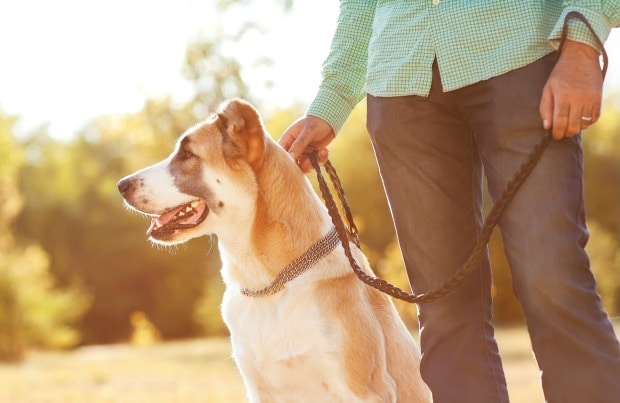In exchange for daily kibbles, a scratch on the head, and a warm place to sleep, our tail-wagging pups worship us. So let’s go all-out and show them how much we really care by taking them for a walk.
Sure, it’s not a fancy or over-the-top gift, but it’s the ultimate present for a dog. And, as it turns out, it’s one of the best gifts you can give to yourself, too. Keep reading for ten reasons to take your four-legged friend for a walk right now.
Your dog will live longer. Nowadays, people are busy and don’t spend a lot of time at home and when we are at home, we’re sedentary. “Our pets mirror that lifestyle,” says Julie Churchill, DVM, Ph.D, associate professor at the College of Veterinary Medicine, University of Minnesota. “Because of this change in lifestyle, obesity among cats and dogs is becoming an epidemic.”
An estimated 52.7 percent of dogs in the United States are overweight or obese, and that number continues to rise, according to the Association of Pet Obesity Prevention (APOP). Being overweight or obese impacts the quality of your pet’s life. It can cause arthritis, Type II diabetes, high blood pressure, ligament strains and tears, heart and breathing problems, and an increase risk of cancer. Churchill says most obese pets need more medications and have shorter lifespans.
Even if your pet isn’t covered in rolls, doesn’t mean he shouldn’t lose a few. “Even the animals we see on pet food commercials are about 15 to 20 percent over the healthy ideal of weight,” Churchill says. “This new mental model of what ‘healthy’ looks like has been normalized.”
Daily exercise will help combat this problem. Churchill says to follow the American Academy of Pediatrics’ recommendation of an hour of activity a day. If your pet is new to an exercise routine, check out APOP’s starter walking plan for weight loss.
You’ll stick around longer, too. Dog owners are more likely to avoid the reaper, as researchers in the United Kingdom discovered by examining the health status of pet owners. Dog owners exercised much more than cat owners (thanks to dog walking) and had lower blood pressure and cholesterol.
You’ll lose your spare tire. The American College of Sports Medicine found that dog owners who regularly walk their pups have a significantly lower body mass index, along with daily activity levels that are 11 percent higher than those who don’t walk their pets. Also, you’re getting a better quality of exercise than if you walked alone or with another person. A University of Missouri study found that walking with a puppy leaders to a 28 percent increase in walking speed, compared to only a 4 percent increase when strolling with a human.
It’ll put a smile on your face. Research has found that petting, playing, and walking with your pet can boost levels of serotonin and dopamine—or “feel good” hormones—in your body, reducing stress, anxiety, and loneliness.
You’ll meet more people. Owning and walking a dog increases human interaction, according to a study from the University of Western Australia. You’re more likely to greet other people in the street, exchange favors with neighbors, and meet others living near by, the researchers say.
That’s because it’s a lot easier to strike up a conversation with a stranger when you have an awesome topic to talk about—like Rufus at the end of your dog leash. “There’s a social aspect to walking your dog,” says Churchill. “In her neighborhood, people are more likely to memorize your pooch’s name before your name,” she says.
Your dog will meet more friends, too. Dogs were born to hunt herd, provide protection, scavenge, and socialize in packs. But most owners have to keep their dogs indoors during the day or in a fenced-in yard. Our pooches can often forget how to interact with other animals. They may even be scared, fearful, or intimidated.
“Daily walks can help your dog boost his confidence,” says Churchill. You’ll have the opportunity to introduce your pet to other people, friendly dogs, and new environments. This can be a trying experience for many shy or timid dogs, so make sure you ask your vet for tips and tricks on how to make this the most pleasant situation as possible for your four-legged friend.
You might score a date. Start to think of your dog as a built-in tail-wagging wingman or wing-woman. In a series of studies at the University of Pennsylvania, volunteers rated photographs with the same people shown with or without a canine. The reviewers consistently rated the human subjects shown with dogs as happier, and more relaxed. They also reported wanting to be in the pictures with those subjects much more often, too.
And these feelings transfer to real life. Researchers asked volunteers to go on walks by themselves or with a canine. Solo walkers tended to stay that way, while those accompanied by a friendly dog increased their social encounters.
You love your brand new shoes—and you want to keep them looking new. When dogs don’t get enough exercise, they need to expend their energy elsewhere. And that’s when your shoes, belts, yard, or furniture can take a beating. According to the ASPCA, lack of play or activity can result in obsessive whining and barking and destructive behaviors like chewing, digging, and scratching.
Your pet will sleep like a puppy. In humans, exercise can promote sleep. So it makes sense that the same is true for dogs. Daily walks can help your pet feel sleepy—not restless—at the end of the day, says Churchill. Bonus: He’s ready to hit the hay when you’re winding down for the night.
It will strengthen your bond. You were told your dog would be your best friend. But if that’s not true yet, you’ve got some work do. “You must foster this relationship, helping it grow over time,” says Churchill. “If you want him to be attentive to you, then you must be attentive to him.”
Think of every walk as a training opportunity to build trust and experience between the two of you. Don’t just look at your phone while you walk—make these strolls interactive. Ask your pup to sit at the corners, set different paces so he has to slow down or speed up, or change up the side that you normally walk on. Read your dog’s body language, gauge his energy level and make sure he doesn’t need extra exercise.
Spend enough time focused on each other during these walks, and you’ll increase the connection you two share. Both you and your dog will pick up on each other cues more quickly and you’ll start to move more fluidly together.
Image via Shutterstock
Jill Fanslau
Share:









